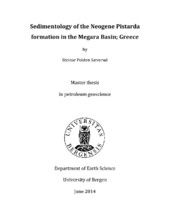Sedimentology of the Neogene Pistarda formation in the Megara Basin; Greece
Master thesis
Permanent lenke
https://hdl.handle.net/1956/8365Utgivelsesdato
2014-06-02Metadata
Vis full innførselSamlinger
- Department of Earth Science [1103]
Sammendrag
The Pistarda formation in the Megara Basin has not been studied in detail before. The aim of this thesis is to provide sedimentological and geochemical data, in order to increase our understanding of the depositional processes and environments of the Pistarda formation. Ten localities were found and nine of them were logged. The focus was on the vertical and lateral facies variations and trying to explain how it initiated and how it terminated. The Pistarda formation is a half-graben with a dip towards the northeast. The localities were found higher up the dip-slope. Seven facies were identified, of which many showed evidence of in situ materials, indicating a shallow lacustrine environment. Some of the localities showed evidence of two units, a lower and an upper unit. When a clear difference was found between the units, the lower usually consisted of reworked material, while the upper had more in situ facies. The same interpretation is made when linking this to the geochemistry. Analysis of δ18O, δ13C and 87Sr/86Sr ratio confirms that the formation has two units, where the lower shows evidence of being deposited by a larger and deeper lake. The opposite is found for the upper unit, showing evidence of being deposited by a smaller and shallower lake. The structural data from the area links the development of the two units to a fault which created the accumulation space needed for the two units to form in quite a small area in the Megara basin. The development of the Pistarda formation is interpreted to be linked with shifts in the climate during the deposition, which could support the development of a lake.
